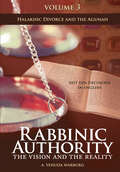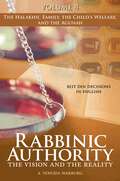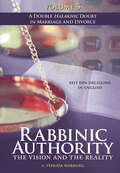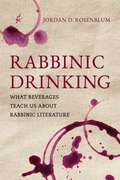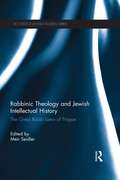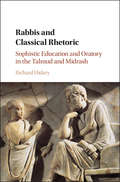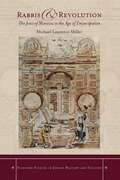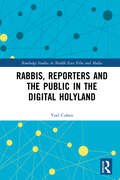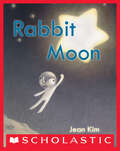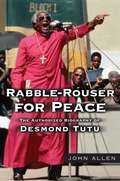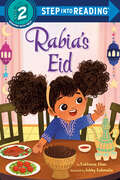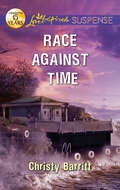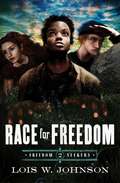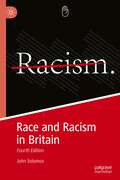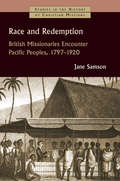- Table View
- List View
Rabbinic Authority, Volume 3: The Vision and the Reality, Beit Din Decisions in English - Halakhic Divorce and the Agunah
by A. Yehuda WarburgIn the third volume of his groundbreaking series on rabbinic authority in English, Rabbi Warburg discusses the ramifications of a Jewish divorce. In this well-composed monograph, Rabbi Warburg primarily focuses on the case of the modern day agunah, a wife who is unable to get divorced due to her husband's recalcitrance. He addresses the various techniques, such as obligating the giving of a get (Jewish divorce document), finding relief for an agunah who signed an exploitative agreement, and listing different avenues to void a marriage (bitul kiddushin) used by the rabbinical court. This issue is of some controversy in the Jewish community, and there is heated debate about it.
Rabbinic Authority, Volume 4: The Vision and the Reality, Beit Din Decisions in English - The Halakhic Family, the Child's Welfare, and the Agunah (Rabbinic Authority)
by A. Yehuda WarburgIn this fourth volume of his groundbreaking series on rabbinic authority in English, Rabbi Warburg discusses the ramifications of the family and the child's welfare, as well as the case of the modern day agunah, a wife who is unable to get divorced due to her husband's recalcitrance.
Rabbinic Authority, Volume 5: The Vision and the Reality, Beit Din Decisions in English - A Double Halakhic Doubt in Marriage and Divorce (Rabbinic Authority)
by A. Yehuda WarburgIn this fifth volume of his groundbreaking series on rabbinic authority, Rabbi Warburg discusses the case of the modern-day agunah, a wife who is unable to obtain a divorce due to her husband' s recalcitrance. For the first time in English, this monograph discusses utilizing the technique of the double halakhic doubt (sefek sefeika de'dina) as a vehicle to void a marriage, in order to address the plight of the agunah. This volume is devoted primarily to demonstrate how a beit din or rabbinical authority(ies) can take care of this complicated issue, especially for those decisors who reject the various other options to void a marriage.
Rabbinic Drinking: What Beverages Teach Us About Rabbinic Literature
by Jordan D. RosenblumThough ancient rabbinic texts are fundamental to analyzing the history of Judaism, they are also daunting for the novice to read. Rabbinic literature presumes tremendous prior knowledge, and its fascinating twists and turns in logic can be disorienting. Rabbinic Drinking helps learners at every level navigate this brilliant but mystifying terrain by focusing on rabbinic conversations about beverages, such as beer and wine, water, and even breast milk. By studying the contents of a drinking vessel—including the contexts and practices in which they are imbibed—Rabbinic Drinking surveys key themes in rabbinic literature to introduce readers to the main contours of this extensive body of historical documents. Features and Benefits:Contains a broad array of rabbinic passages, accompanied by didactic and rich explanations and contextual discussions, both literary and historicalThematic chapters are organized into sections that include significant and original translations of rabbinic textsEach chapter includes in-text references and concludes with a list of both referenced works and suggested additional readings
Rabbinic Judaism in the Making: The Halakhah from Ezra to Judah I
by Alexander GuttmannThrough the ages, theology in Judaism has played roles of varying importance. But the role of theology is minor compared with that of law and observance. This book is devoted to a study of the evolution of normative Judaism from the time of Ezra (ca. 400 B.C.) to Judah I, the Prince (ca. 200 A.D.). Its focus on law represents a realistic approach to the history of applied Judaism. <P><P> Rabbinic Judaism in the Making is the first study in English to trace the evolution of Rabbinic Law and Rabbinic Judaism. A concise history of post-biblical normative Judaism in antiquity, Mr. Guttmann's book concentrates on the crucial inter-testamental period, and should be valuable to students of ancient history, and both Christian and Jewish theologians, ministers, and rabbis.
Rabbinic Judaism: Space and Place (Routledge Jewish Studies Series)
by David KraemerIn the aftermath of the conquest of the Holy Land by the Romans and their destruction of the Jerusalem Temple in 70 CE, Jews were faced with a world in existential chaos—both they and their God were rendered homeless. In a religious tradition that had equated Divine approval with peaceful dwelling on the Land, this situation was intolerable. So the rabbis, aspirants for leadership of the post-destruction Jewish community, appropriated inherited traditions and used them as building blocks for a new religious structure. Not unexpectedly, given the circumstances, this new rabbinic formation devoted considerable attention to matters of space and place. Rabbinic Judaism: Space and Place offers the first comprehensive study of spatiality in Rabbinic Judaism of late antiquity, exploring how the rabbis reoriented the Jewish relationship with space and place following the destruction of the Jerusalem temple. Drawing upon the insights of theorists such as Tuan and LeFebvre, who define the crisis that "homelessness" represents and argue for the deep relationship of human societies to their places, the book examines the compositions of the rabbis and discovers both a surprisingly aggressive rabbinic spatial imagination as well as places, most notably the synagogue, where rabbinic attention to space and place is suppressed or absent. It concludes that these represent two different but simultaneous rabbinic strategies for re-placing God and Israel—strategies that at the same time allow God and Israel to find a place anywhere. This study offers new insight into the centrality of space and place to rabbinic religion after the destruction of the Temple, and as such would be a key resource to students and scholars interested in rabbinic and ancient Judaism, as well as providing a major new case study for anthropologists interested in the study of space.
Rabbinic Theology and Jewish Intellectual History: The Great Rabbi Loew of Prague (Routledge Jewish Studies Series)
by Meir SeidlerRabbi Loew (the Maharal) of Prague remains one of the most influential and prolific Jewish thinkers of his time. Widely considered one of the fathers of Hassidic thought and a harbinger of Modern Jewish philosophy, his life and work have retained their influence and remain prevalent today. Adopting a multi-disciplinary approach, this book ranges from an analysis of the historical background to Maharal’s thought, to examining the relevance of this thought in the modern era, before addressing the popular cultural and folkloristic reception of Maharal’s impact on modern, Western culture. This book presents a new understanding of familiar material and will be an invaluable asset to students and scholars of Modern and Early-Modern Jewish History and Intellectual thought.
Rabbis and Classical Rhetoric: Sophistic Education and Oratory in the Talmud and Midrash
by Richard HidaryTraining in rhetoric - the art of persuasion - formed the basis of education in the Roman Empire. The classical intellectual world centered around the debate between philosophers, who boasted knowledge of objective reality, and sophists, who could debate both sides of any issue and who attracted large audiences and paying students. The roles of the Talmudic rabbis as public orators, teachers, and jurists, parallel that of Roman orators. Rabbinic literature adopted and adapted various aspects of the classical rhetorical tradition, as is demonstrated in the Talmudic penchant for arguing both sides of hypothetical cases, the midrashic hermeneutical methods, and the structure of synagogue sermons. At the same time, the rabbis also resisted the extreme epistemological relativism of rhetoric as is evident in their restraint on theoretical argumentation, their depiction of rabbinic and divine court procedure, and their commitment to the biblical prophetic tradition. Richard Hidary demonstrates how rabbis succeeded in navigating a novel path between platonic truth and rhetorical relativism.
Rabbis and Revolution: The Jews of Moravia in the Age of Emancipation
by Michael Laurence MillerThe Habsburg province of Moravia straddled a complicated linguistic, cultural, and national space, where German, Slavic, and Jewish spheres overlapped, intermingled, and sometimes clashed. Situated in the heart of Central Europe, Moravia was exposed to major Jewish movements from the East and West, including Haskalah (Jewish enlightenment), Hasidism, and religious reform. Moravia's rooted and thriving rabbinic culture helped moderate these movements, and in the case of Hasidism, keep it at bay. During the Revolution of 1848, Moravia's Jews took an active part in the prolonged and ultimately successful struggle for Jewish emancipation in the Habsburg lands. The revolution ushered in a new age of freedom, but it also precipitated demographic, financial, and social transformations, disrupting entrenched patterns that had characterized Moravian Jewish life since the Middle Ages. These changes emerged precisely when the Czech-German conflict began to dominate public life, throwing Moravia's Jews into the middle of the increasingly virulent nationality conflict. For some, a cautious embrace of Zionism represented a way out of this conflict, but it also represented a continuation of Moravian Jewry's distinctive role as mediator-and often tamer-of the major ideological movements that pervaded Central Europe in the Age of Emancipation.
Rabbis of our Time: Authorities of Judaism in the Religious and Political Ferment of Modern Times (Routledge Jewish Studies Series)
by Marek Čejka Roman KořanThe term ‘rabbi’ predominantly denotes Jewish men qualified to interpret the Torah and apply halacha, or those entrusted with the religious leadership of a Jewish community. However, the role of the rabbi has been understood differently across the Jewish world. While in Israel they control legally powerful rabbinical courts and major religious political parties, in the Jewish communities of the Diaspora this role is often limited by legal regulations of individual countries. However, the significance of past and present rabbis and their religious and political influence endures across the world. Rabbis of Our Time provides a comprehensive overview of the most influential rabbinical authorities of Judaism in the 20th and 21st Century. Through focussing on the most theologically influential rabbis of the contemporary era and examining their political impact, it opens a broader discussion of the relationship between Judaism and politics. It looks at the various centres of current Judaism and Jewish thinking, especially the State of Israel and the USA, as well as locating rabbis in various time periods. Through interviews and extracts from religious texts and books authored by rabbis, readers will discover more about a range of rabbis, from those before the formation of Israel to the most famous Chief Rabbis of Israel, as well as those who did not reach the highest state religious functions, but influenced the relation between Judaism and Israel by other means. The rabbis selected represent all major contemporary streams of Judaism, from ultra-Orthodox/Haredi to Reform and Liberal currents, and together create a broader picture of the scope of contemporary Jewish thinking in a theological and political context. An extensive and detailed source of information on the varieties of Jewish thinking influencing contemporary Judaism and the modern State of Israel, this book is of interest to students and scholars of Jewish Studies, as well as Religion and Politics.
Rabbis, Reporters and the Public in the Digital Holyland (Routledge Studies in Middle East Film and Media)
by Yoel CohenFocused on the triangular relationship between rabbis, journalists and the public, this book analyses each group’s role in influencing the agenda around religion in Israel. The book draws upon the author's original research, comprising an analysis of the coverage of religion on four Israeli news websites, a series of surveys of rabbis, journalists, and the public, as well as a large number of interviews conducted with a range of stakeholders: community rabbis, teacher rabbis, and religious court judges; reporters, editors, and spokespersons; and the Israeli Jewish public. Key questions include: What are rabbis’ philosophical views of the media? How does the media define news about Judaism? What aspect of news about religion and spirituality interest the public? How do spokespersons and rabbis influence the news agenda? How is the triangular relationship between rabbis, journalists and the public being altered by the digital age? Despite a lack of understanding about mass media behaviour among many rabbis, and, concurrently, a lack of knowledge about religion among many journalists, it is argued that there is shared interest between the two groups, both in support of mass-media values like the right to know and freedom of expression. It is further argued that the public's attitude to news about religion is significant in determining what journalists should publish. The book will be of interest to those studying mass communications, the media, Judaism and Israeli society, as well as researchers of media and religion.
Rabbis, Reporters and the Public in the Digital Holyland (Routledge Studies in Middle East Film and Media)
by Yoel CohenFocused on the triangular relationship between rabbis, journalists and the public, this book analyses each group’s role in influencing the agenda around religion in Israel.The book draws upon the author's original research, comprising an analysis of the coverage of religion on four Israeli news websites, a series of surveys of rabbis, journalists, and the public, as well as a large number of interviews conducted with a range of stakeholders: community rabbis, teacher rabbis, and religious court judges; reporters, editors, and spokespersons; and the Israeli Jewish public. Key questions include: What are rabbis’ philosophical views of the media? How does the media define news about Judaism? What aspect of news about religion and spirituality interest the public? How do spokespersons and rabbis influence the news agenda? How is the triangular relationship between rabbis, journalists and the public being altered by the digital age? Despite a lack of understanding about mass media behaviour among many rabbis, and, concurrently, a lack of knowledge about religion among many journalists, it is argued that there is shared interest between the two groups, both in support of mass-media values like the right to know and freedom of expression. It is further argued that the public's attitude to news about religion is significant in determining what journalists should publish.The book will be of interest to those studying mass communications, the media, Judaism and Israeli society, as well as researchers of media and religion.
Rabbit Moon
by Jean KimRabbit Moon weaves together a tale of wishes, play, loneliness, and friendship -- beautifully illustrated in a style that evokes Kevin Henkes, Jon Muth, Shaun Tan, and Renata Liwska.Bedtime wishes take flight on paper airplanes, traveling all the way to the moon. There Rabbit gathers the night's haul, grinds the wishes into stardust, and fills the sky with their starlight. It is a beautiful sight to behold, but lonely work. So one night, Rabbit takes a wish and makes it float down to earth; when it comes true, he makes new friends and the star work takes a back seat to some well-earned fun. But as each day fades, so do the night stars. And with the first starless sky, Rabbit realizes it's time to make the journey home. It is a sad departure, but Rabbit's friends make one last wish, and send an astronomical gift.
Rabble-Rouser for Peace: The Authorized Biography of Desmond Tutu
by John AllenTo be a rabble-rouser for peace may seem to be a contradiction in terms. And yet it is the perfect description for Desmond Tutu, Nobel laureate and spiritual father of a democratic South Africa. Tutu understood that justice -- a genuine regard for human rights -- is the only real foundation for peace. And so he stirred up trouble, courageously engaging in heated face-to-face confrontations with South Africa's leaders; he stirred up trouble in the streets, leading peaceful demonstrations amid the barely controlled fury of police battalions; he stirred up trouble on the world stage, seeking international disinvestment in the apartheid economy. Tutu has led one of the great lives of the late twentieth and early twenty-first centuries, and to read his story in full is to be reminded of the power of one inspired man to change history. In this authorized biography, written by John Allen, a distinguished journalist and longtime associate of Tutu, we are witnesses to courage, stirring oratory, and a demonstration of the power of faith to transform the seemingly intransigent. We know in retrospect that the apartheid resistance movement was successful and that South Africa, though not without its problems, today faces an infinitely brighter future than it might if it had not been for the efforts of Desmond Tutu, Nelson Mandela, and other leaders. But no such outcome was ever a certainty. Through the author's personal experiences, total access to the Tutu family and their papers, and considerable research, including the use of new archival material, Allen tells the story of a barefoot schoolboy from a deprived black township who became an international symbol of the democratic spirit and of religious faith. Allen personally observed how Tutu, at genuine risk to his own safety, repeatedly intervened between armed soldiers and stone-throwing students to keep the peace, how he faced constant death threats and angrily stood up to the leaders of the cruel apartheid system. Using his own faith as a cudgel, Tutu asked those officials to confront their own Christian background and made them reconcile their actions with their own professions of belief. Often through the sheer power of moral example and with a lyrical command of the English language, Tutu was able to appeal to the conscience of the world and to the emotions of an angry crowd in the streets. And then, when the battle for South African rights was finally won, it was Tutu who insisted on finding a path to forgive the former oppressors by strongly backing and serving on the unprecedented Truth and Reconciliation Commission. Today, the archbishop continues to appeal to the world's conscience by opposing the continuance of war and the inadequacy of the international response to the AIDS/HIV crisis sweeping Africa. He has led a life of commitment, one that continues to matter. John Allen has movingly captured the flavor and details of that life and marshaled them into a commanding story, one that sheds light on the struggles and triumphs of our times.
Rabi'a From Narrative to Myth: The Many Faces of Islam's Most Famous Woman Saint, Rabi‘a al-‘Adawiyya
by Rkia Elaroui CornellRabi&‘a al-&‘Adawiyya is a figure shrouded in myth. Certainly a woman by this name was born in Basra, Iraq, in the eighth century, but her life remains recorded only in legends, stories, poems and hagiographies. The various depictions of her – as a deeply spiritual ascetic, an existentialist rebel and a romantic lover – seem impossible to reconcile, and yet Rabi&‘a has transcended these narratives to become a global symbol of both Sufi and modern secular culture. In this groundbreaking study, Rkia Elaroui Cornell traces the development of these diverse narratives and provides a history of the iconic Rabi&‘a&’s construction as a Sufi saint. Combining medieval and modern sources, including evidence never before examined, in novel ways, Rabi&‘a From Narrative to Myth is the most significant work to emerge on this quintessential figure in Islam for more than seventy years.
Rabia's Eid (Step into Reading)
by Rukhsana KhanJoin a young girl and her family in this Step 2 reader as they celebrate Eid-al-fitr, a holiday that marks the end of the Islamic holy month of Ramadan. Perfect for readers ages 4-6.It's Eid-al-fitr—the last day of Ramadan, which means it is the last day for Rabia to fast with the rest of her family and she has never done it before. Rabia is so excited! She eats just before sunrise and then the day of fasting begins! Rabia gets to have her hands painted with henna, wear a new dress, and put her family's donation in the box at the mosque. It's a special Eid all around!Step 2 Readers use basic vocabulary and short sentences to tell simple stories, for children who recognize familiar words and can sound out new words with help.
Race Against Time
by Christy BarrittWere it not for her cop neighbor, widowed mother Madison Jacobs would be dead. Thankfully, Detective Brody Philips interrupts an attempt on her life in the nick of time. But the would-be killer hasn't given up, and each tick of the clock brings the madman closer to finishing what he started. Brady vows to catch the serial killer plaguing the sleepy Virginia town...especially when he realizes the danger has followed him from the big city. With everyone around him at risk, it'll take everything Brody's got to do his duty and keep Madison and her son safe.
Race Against Time (Mills And Boon Love Inspired Suspense Ser.)
by Christy BarrittA single mother is caught in a killer’s crosshairs and needs a protector in this suspenseful romance from USA TODAY bestselling author Christy Barritt.Were it not for her cop neighbor, widowed mother Madison Jacobs would be dead. Thankfully, Detective Brody Philips interrupts an attempt on her life in the nick of time. But the would-be killer hasn’t given up, and each tick of the clock brings the madman closer to finishing what he started. Brady vows to catch the serial killer plaguing the sleepy Virginia town…especially when he realizes the danger has followed him from the big city. With everyone around him at risk, it’ll take everything Brody’s got to do his duty and keep Madison and her son safe.From Love Inspired Suspense: Courage. Danger. Faith.
Race For Freedom (Freedom Seekers #2)
by Lois Walfrid JohnsonLate at night, as the Christina puts out into the Mississippi River, Caleb and Libby keep watch on deck. Close by, the runaway slave, Jordan, creeps forward without a sound. Drawing near the lantern, he stops, as if afraid to enter the circle of light. On the streets above them no one stirs. Then a dark shape steps from the shadows. Jordan moans. "It's Riggs!" (The slave-trader. ) The cruelest man Caleb knows. Jordan's owner stepping out, so they know he's on their trail. From that moment the Freedom Seekers can never forget that because of a fugitive slave law Jordan can be taken back into slavery, even from a free northern state. Nor can they forget that if Captain Norstad is caught hiding a fugitive he can lose the Christina. Then Elsa, a new-found immigrant friend, faces illness and possible death. Will Libby's need for courage bring her to the Lord who promises, "Do not fear, for I am with you"? Can the Freedom Seekers live the courage that offers life, liberty, and the pursuit of happiness to every person? Can they go beyond fear to put that courage into practice? As steamboats race for St. Paul, stakes are high. To escape capture, Jordan makes a mighty leap. In a time when captains did not stop for a man overboard, will Jordan survive his fall into icy waters? The Freedom Seekers series is a six-novel middle-reader set in 1857. Feel the rush of immigrants to the new land, and the dangers of the Underground Railroad in these true-to-life Riverboat stories. The characters will receive a heart-warming response from readers of all ages. Adult readers will ask themselves, "Would I have been one of those who helped runaway slaves?" Lois Walfrid Johnson uses strong historical research, great writing, and wonderful storytelling to bring alive a critical time in American history.
Race You to the Fountain of Youth
by Martha Bolton Brad DicksonThe men are on one side. The women on the other. They're ready -- they're set -- they're off!... Well...maybe not. Seasoned comedy writers Martha Bolton and Brad Dickson take an unconventional, refreshing look at the over-forty race to the Fountain of Youth. Instead of heaping on the pressure to exercise more, eat less, manage your time, and save all your money for retirement, Bolton and Dickson offer a take-it-easy approach to aging with chapters like: If Menopausal Women Ruled the World How to Calculate Your Real Age I Am Woman, Where'd I Go? Desperate Grandmas He Died of What? Gimme a Head with Hair Filled with gentle encouragement and rolling humor, Race You to the Fountain of Youth will remind you to focus on the things that truly matter -- contentment, personal growth, faith, and joy. Relevant, real, and always funny, this look at the better half of life doesn't ask you to change one thing about yourself -- except maybe to laugh a bit more and worry a bit less.
Race and Place: How Urban Geography Shapes the Journey to Reconciliation
by Soong-Chan Rah David P. LeongGeography matters.Race and Place
Race and Political Theology
by Vincent W. LloydSenior scholars come together to explore how Jewish and African American experiences can make us think differently about the nexus of religion and politics, or political theology. Some wrestle with historical figures, such as William Shakespeare, W. E. B. Du Bois, Nazi journalist Wilhelm Stapel, and Austrian historian Otto Brunner. Others ponder what political theology can contribute to contemporary politics, particularly relating to Israel's complicated religious/racial/national identity and to the religious currents in African American politics. Race and Political Theologyopens novel avenues for research in intellectual history, religious studies, political theory, and cultural studies, showing how timely questions about religion and politics must be reframed when race is taken into account.
Race and Racism in Britain: Fourth Edition
by John SolomosThis Fourth Edition of a pioneering handbook provides a critical analysis of the origins and evolution of political and policy debates regarding race and racism in British society. Drawing on a broad range of both theoretical and historical research, the focus of the book is on the development of policies and debates in the period from the second half of the 20th Century to the present. The book is organized into twelve chapters which provide an overview of key trends, situating the development of policies and developments in relation to immigration and citizenship, race relations policies and broader agendas about multiculturalism and living with difference. In the substantive chapters of the book there is also a detailed discussion of such issues as policing, urban unrest and protest, racist politics, black and ethnic minority politics and conversations about multiculturalism. This new edition engages with both the historical background as well as contemporary developments to provide a novel and wide-ranging account of the role that questions about race and racism play in British society.
Race and Redemption: British Missionaries Encounter Pacific Peoples, 1797-1920 (Studies in the History of Christian Missions (SHCM))
by Jane SamsonRace and Redemption is the latest volume in the Studies in the History of Christian Missions series, which explores the significant, yet sometimes controversial, impact of Christian missions around the world. In this historical examination of the encounter between British missionaries and people in the Pacific Islands, Jane Samson reveals the paradoxical yet symbiotic nature of the two stances that the missionaries adopted—"othering" and "brothering." She shows how good and bad intentions were tangled up together and how some blind spots remained even as others were overcome. Arguing that gender was as important a category in the story as race, Samson paints a complex picture of the interactions between missionaries and native peoples—and the ways in which perspectives shaped by those encounters have endured.
Race and Redemption: British Missionaries Encounter Pacific Peoples, 1797-1920 (Studies in the History of Christian Missions (SHCM))
by Jane SamsonRace and Redemption is the latest volume in the Studies in the History of Christian Missions series, which explores the significant, yet sometimes controversial, impact of Christian missions around the world. In this historical examination of the encounter between British missionaries and people in the Pacific Islands, Jane Samson reveals the paradoxical yet symbiotic nature of the two stances that the missionaries adopted—"othering" and "brothering." She shows how good and bad intentions were tangled up together and how some blind spots remained even as others were overcome. Arguing that gender was as important a category in the story as race, Samson paints a complex picture of the interactions between missionaries and native peoples—and the ways in which perspectives shaped by those encounters have endured.
